-
11 March 2011
A magnitude 9.0 earthquake hits 130 kilometers off Japan's northeastern coast at 2:46 P.M. local time. Several nuclear power plants automatically shut down; the Fukushima Daiichi nuclear power complex loses its connection to the electrical grid and diesel generators kick in to continue delivering power to circulated cooling water around the hot nuclear core.
Diesel generators at Fukushima Daiichi shut down at 3:27 P.M. local time after getting slammed by a series of seven tsunamis, some as high as 15 meters.
That evening the Japanese government issues a state of emergency, and officials evacuate thousands of people living within a three-kilometer radius of the power plant.
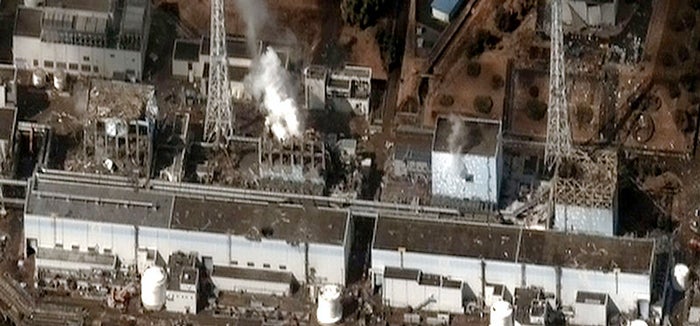
Credit: Wikimedia Commons/Digital Globe
-
12 March 2011
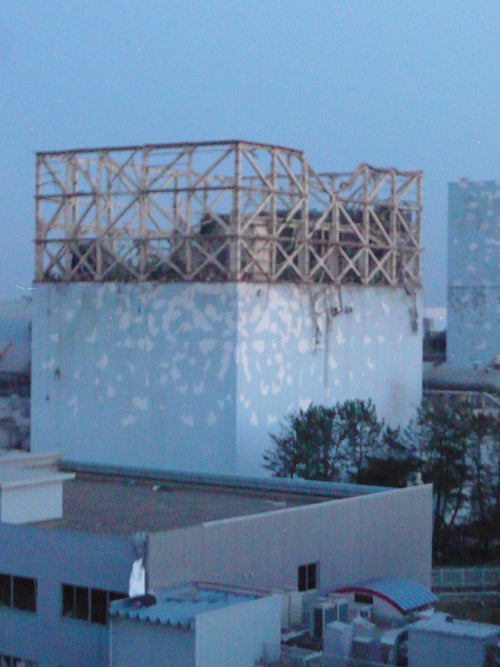 The Japanese government announces residential evacuation within 10 kilometers of the Fukushima Daiichi and Fukushima Daini nuclear power plants. With the flow of coolant interrupted, hot nuclear fuel boils the surrounding water, raising pressures in reactor units 1 and 2 at Fukushima Daiichi.
The Japanese government announces residential evacuation within 10 kilometers of the Fukushima Daiichi and Fukushima Daini nuclear power plants. With the flow of coolant interrupted, hot nuclear fuel boils the surrounding water, raising pressures in reactor units 1 and 2 at Fukushima Daiichi.A hydrogen explosion (left) blows the roof off of the Unit 1 reactor building and collapses the walls surrounding the pool where spent nuclear fuel rods are kept cool..
Residents within 20 kilometers of the plant are evacuated.
Radioactive cesium 137 and iodine 131 are detected near the power plant.
TEPCO (Tokyo Electric Power Company) begins injecting seawater, which corrodes pumps and pipelines, as a substitute coolant into Unit 1; water levels fall in Unit 2.
Credit: Tokyo Electric Power Company
-
13 March 2011
Freshwater and then seawater are pumped to cool reactor 3, and air venting begins.
Chief Cabinet Secretary Yukio Edano says that a partial meltdown in Unit 3 is "highly possible."
The International Atomic Energy Agency finds normal radiation levels outside Fukushima Daiichi.
-
14 March 2011
Falling water levels in reactors 1, 2 and 3 expose the upper portions of active nuclear fuel.
Seawater is pumped into the Unit 2 reactor.
A hydrogen explosion occurs in the reactor Unit 3 building, injuring several workers and damaging the building's upper structure. The reactor's spent fuel pool is exposed to the atmosphere.
-
15 March 2011
 A hydrogen explosion occurs in the Unit 2 building; officials suspect that part of the unit's primary containment structure is damaged.
A hydrogen explosion occurs in the Unit 2 building; officials suspect that part of the unit's primary containment structure is damaged.A fire breaks out in the Unit 4 reactor building(left). Japanese authorities believe that the spent fuel storage pool is burning, releasing radiation into the atmosphere..
Seawater pumping continues on reactor units 1, 2, and 3.
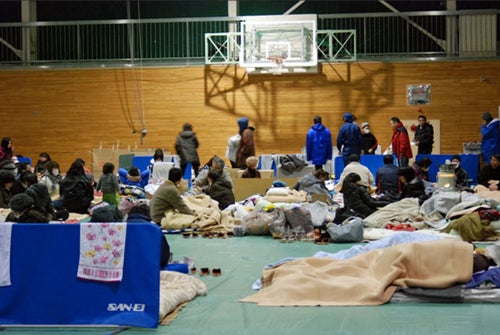 A fire breaks out in the unit 4 reactor building. Japanese authorities believe that the spent fuel storage pool is burning, releasing radiation into the atmosphere.
A fire breaks out in the unit 4 reactor building. Japanese authorities believe that the spent fuel storage pool is burning, releasing radiation into the atmosphere.Radiation readings taken near the plant show emissions of up to 400 millisieverts per hour, compared with the average person's exposure rate of 2.4 millisieverts per year. (A sievert is a unit of ionizing radiation equal to 100 rems; a rem is a dosage unit of x-ray and gamma-ray radiation exposure.) Officials ask residents within 30 kilometers of the plant to stay indoors, and some Fukushima Daiichi staff are evacuated.
Evacuees gather at Koriyama High School gymnasium (bottom left), Koryiama, Fukushima Prefecture on March 16. Credit: Steve Herman/Wikimedia Commons, Tokyo Electric Power Company (top left)
-
16 March 2011
TEPCO estimates that many of Fukushima Daiichi's fuel rods have suffered damage, including 70 percent of the fuel in Unit 1 and 33 percent in Unit 2. The utility suspects that Unit 3's core is also damaged.
Workers continue seawater injection.
-
17 March 2011
Military helicopters dump seawater into Unit 3.
Radiation levels measured by TEPCO read as high as 170 millisieverts per hour.
-
19 March 2011
Workers continue dousing units 1, 2 and 3 in seawater.
A replacement diesel generator provides power to pump water into Units 5 and 6.
Milk and water from the Fukushima area are found to have excessively high levels of radioactive iodine. Tap water in Tokyo, 225 kilometers from Fukushima, also carries elevated levels of radiation.
-
20 March 2011
Temperatures stabilize in units 5 and 6, which reach safe "cold shutdown" conditions, or temperatures below the boiling point of water.
Electrical power from the grid is restored at Unit 2.
-
21 March 2011
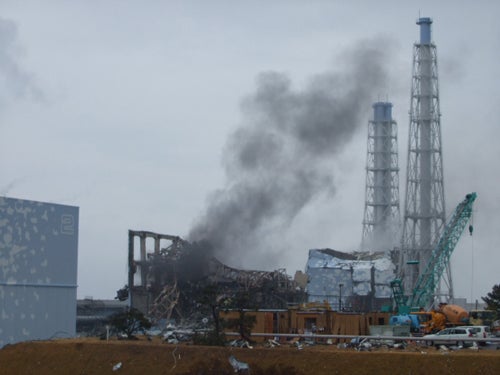
Black smoke billows from the collapsing reactor building of Unit 3, forcing a temporary evacuation of workers from the power plant.
Off-site power is now available to units 1, 2, 5 and 6.
Credit: Tokyo Electric Power Company.
-
22 March 2011
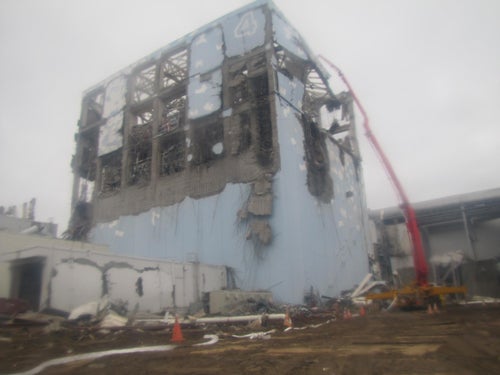
Workers are still pumping seawater in units 2, 3 and 4 (left).
TEPCO announces that samples taken south of the plant contain radioactive iodine that exceeds by 126.7 times legal limits for wastewater. Cesium 134, which has a half-life of two years, exceeds the maximum by 24.8 times, and cesium 137 (whose half-life is 30 years) is in excess by 16.5 times.
Electrical power is now restored to all reactor control rooms.
Credit: Tokyo Electric Power Company.
-
23 March 2011
Radiation far above legal limits is found in 11 types of vegetables from the Fukushima area; shipments are halted.
The Tokyo Water Bureau announces that Tokyo's tap water contains up to 210 becquerels per liter of iodine 131, more than twice the recommended limit for infants. (One becquerel represents the rate of radioactive decay—or radiation emitted by a substance—as one disintegration, or count, per second.)
-
24 March 2011
Water levels in Unit 4's spent fuel pool are dangerously low; 135 metric tons of seawater are injected.
The Unit 1 reactor reaches nearly 400 degrees Celsius, exceeding its design limit of 302 degrees C.
Smoke is observed coming from units 1, 2, 3 and 4.
Two of the "Fukushima 50" workers are taken to the hospital with radiation burns. While installing electrical cable for Unit 3's reactor pumps, the men waded through irradiated water, which seeped through their protective gear, exposing them to radiation doses as high as 180 millisieverts.
-
25 March 2011
The Japanese government advises residents living between 20 and 30 kilometers from the Fukushima power plant to consider voluntary evacuation.
TEPCO manages to electrically pump freshwater (instead of corrosive seawater) into Unit 1.
Unit 1 reactor temperature decreases from 400 degrees C to a safer 204.5 degrees C.
Two Japanese travelers arriving in China from Tokyo are found to have dangerously high radiation levels and are sent to a hospital.
-
26 March 2011
TEPCO manages to pump freshwater into Unit 2.
Seawater collected at a site 330 meters south of the power plant is found to contain 1,250 times the legal limit of the short-lived radioactive element iodine 131, as compared with a day earlier when it contained 103.9 times the limit. Of the longer-lived radioactive elements, cesium 134 is found to be 117.3 times beyond the normal amount, whereas cesium 137 was detected at 79.6 times its standard.
-
28 March 2011
Water found leaking into the turbine buildings of units 1, 2 and 3 contains radiation levels as high as 1,000 millisieverts per hour, enough to give a fatal dose in four to five hours.
-
30 March 2011
White smoke or steam is observed at units 1, 2, 3 and 4.
Water levels fall in Unit 1, and temperatures rise in Unit 2; fresh water is pumped into both.
Freshwater is delivered into units 1 and 3 using electrical pumps instead of fire trucks.
-
31 March 2011
Japan's Nuclear and Industrial Safety Agency (NISA) says that water sampled near the plant's seawater discharge point contains 4,385 times maximum safety levels, a rise from the previous high of 3,355 times detected on March 29.
1 April 2011
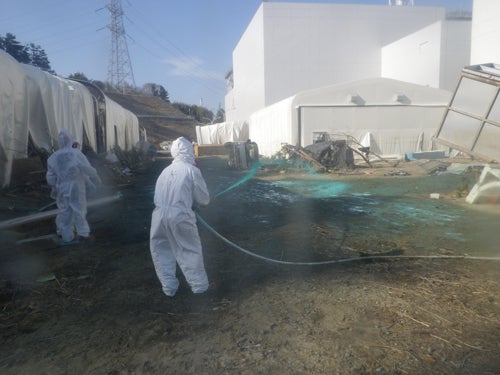
Temperatures stabilize in units 1 and 2.
TEPCO sprays the plant's common spent fuel pool area with an "anti-scattering" agent, which is meant to prevent radioactive particles from being dispersed by winds and rain.
Credit: Tokyo Electric Power Company.
2 April 2011
A 20-centimeter crack near the water intake for Unit 2 is discovered to be leaking irradiated water (at 1,000 millisieverts per hour) into the environment; efforts to fill the crack fail.
Seawater samples reveal radiation contamination at 7.5 million times the legal limit.
Japan's chief cabinet secretary announces that evacuees will not be able to return home in the foreseeable future.
4 April 2011
TEPCO says it need's to dump 11,500 tons of water with "low-level" contamination into the sea, in order to free up storage room for highly contaminated water.
6 April 2011
Workers manage to plug the 20-centimeter crack in Unit 2, which had been leaking for four days.
TEPCO injects 6,000 cubic meters of nitrogen gas into Unit 1 to ensure that any hydrogen buildup does not explode.
Japan's nuclear accident is not expected to have a serious impact on people's health, the U.N. announces.
9 April 2011
Japanese reactor-maker Toshiba says it will take 10 years to decommission the Fukushima power plant.
11 April 2011
Exactly one month after the earthquake and tsunami another earthquake measured at magnitude 7.0 jolts eastern Japan. Fukushima loses power, halting water injections into units 1, 2 and 3 for 50 minutes.
12 April 2011
After receiving new estimates of the total amount of radiation released by the Fukushima crisis, Japan rates the situation as a 7 on the International Atomic Energy Agency's severity scale—the highest rating possible. The radioactivity releases are estimated at about 10 percent of those released from Chernobyl, the only other nuclear incident to receive such a rating.
13–17 April 2011
Crews continue pumping water to cool the spent fuel pools at various units.
Temperatures rise slightly in reactors 2 and 3; Reactor 1's temperatures remain high but continue stabilizing.
To minimize leakage of contaminated water into the sea, workers install steel plates and silt fences on the ocean-facing sides of all four disabled units.
17 April 2011
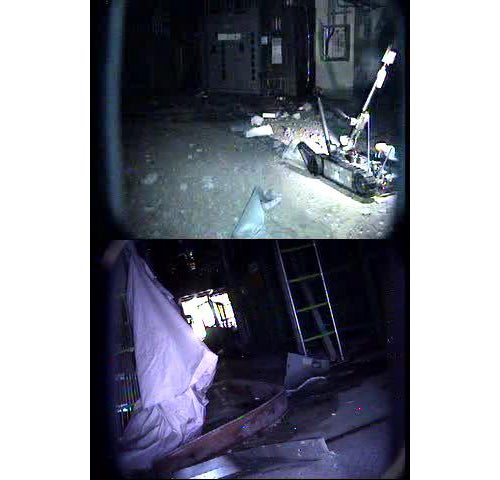
Crews use remote-controlled robots to take radiation readings from inside the reactor buildings of units 1 and 3 (shown on left top and bottom, respectively).
TEPCO outlines a plan to achieve a cold shutdown of all Fukushima Daiichi units by January 2012, including the removal of contaminated water, installation of cooling circulation systems, and halting the release of radioactive materials.
Credit: Tokyo Electric Power Company.
18 April 2011 - 17 June 2011
Crews continue cooling reactors 1, 2 and 3 as well as the spent fuel pools of units 1, 2, 3 and 4.
20 April 2011
The Japanese government bans shipments of some species of fish caught in Fukushima Prefecture after discovering samples tainted with 14,400 becquerels per kilogram of radioactive cesium—much higher than the legal limit of 500 becquerels per kilogram.
21 April 2011
The Japanese government asks TEPCO to pay approximately $12,052 per household to 50,000 households in the region for evacuation reparations.
2 May 2011
Workers begin installing a ventilation system for Unit 1, which will make it safer for workers to replace the reactor's damaged cooling system.
Controversial new guidelines raise the acceptable level of annual radiation exposure in Fukushima Prefecture's elementary schools from one to 20 millisieverts.
5 May 2011
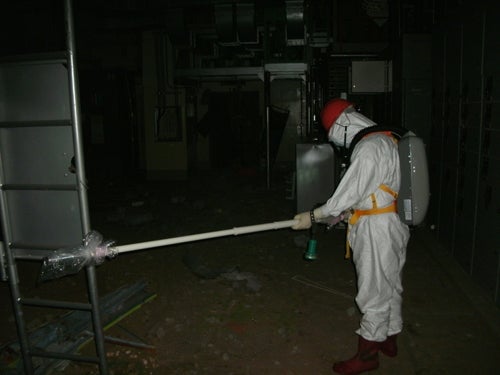
Workers enter and survey the Unit 1 reactor building (left), finding radiation levels as high as 700 millisieverts per hour—nearly three times the 250-millisievert annual exposure limit for nuclear industry workers.
Credit: Tokyo Electric Power Company.
11 May 2011
Evacuees from within Fukushima's 20-kilometer no-entry zone are given two hours to return to their homes to gather important documents and belongings.
10–17 May 2011
TEPCO analyses indicate water levels in the Unit 1 reactor have been dangerously low due to a breach and that the nuclear core has suffered at least a partial meltdown.
27 May 2011
Up to 50 metric tons of highly contaminated water leak from a storage facility.
The Fukushima prefectural government announces that it will provide long-term health checkups to its two million residents.
28 May 2011
In response to parental outrage, Japan's education ministry announces that it has set a new nonbinding target to reduce radiation exposure of students in Fukushima Prefecture schools to one millisievert or less per year.
29 May 2011
Fukushima Prefecture announces plans to reimburse hotels and other tourism-related businesses for reservation cancellations. Over 680,000 guests canceled reservations at inns and hotels in Fukushima Prefecture through the end of June due to the ongoing crisis at the Fukushima power plant, resulting in losses of at least $90 million.
8 June 2011
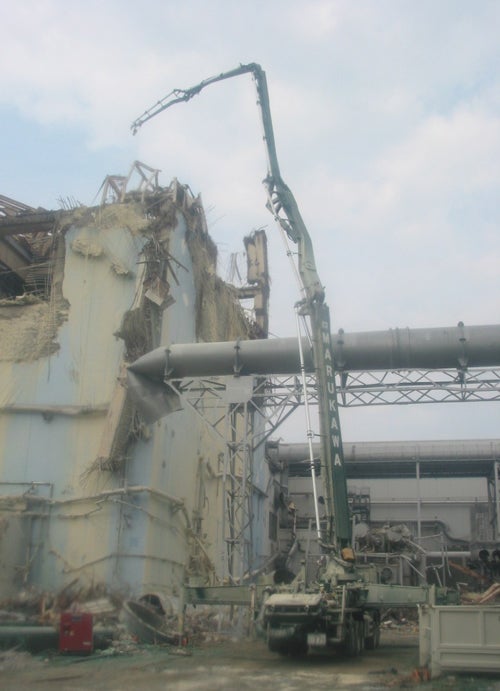
NISA estimates that 770,000 tera-becquerels of iodine 131 have been released during the Fukushima nuclear crisis, up from the 370,000 tera-becquerels it previously estimated.
A crane monitors ambient radioactive substances above the Unit 3 reactor building (pictured on June 13, 2011).
Credit: Tokyo Electric Power Company
11 June 2011
Tokyo's Daily Yomiuri reports that burglars are targeting vacant houses within the 30-kilometer evacuation zone. The newspaper reports that the number of burglaries in Fukushima Prefecture totaled 695 from March to May—a 40 percent increase from the same period last year.
15 June 2011
Fukushima city government announces it will give dosimeters to 34,000 preschool, elementary and junior high school students.
A cattle farmer in Fukushima Prefecture reportedly hangs himself, leaving a suicide note that says, "I wish there wasn't a nuclear plant [in this area]."
18 June—17 August 2011
Safe temperatures are achieved throughout Fukushima's spent fuel pools.
Cooling of reactors 1, 2 and 3 is ongoing; temperatures decline slowly.
19 June 2011
Three hundred elderly pensioners from Japan's Skilled Veterans' Corps offer to give their lives in the battle to bring Fukushima Daiichi under control.
30 June 2011
Small amounts of radioactive substances are found in urine samples of 10 children from Fukushima Prefecture.
14 July 2011
The Fukushima municipal government announces its plans to decontaminate the city's entire area.
24 July 2011
A media poll shows that more than two thirds of Japanese want to end the use of nuclear power.
26 July 2011
The Fukushima prefectural government decides to conduct lifetime checks on the thyroids of all residents who were 18 or younger at the onset of the Fukushima crisis. The prefecture plans to conduct ultrasound exams on 360,000 children between October 2011 and March 2014. After that, subjects will be tested biennially.
29 July 2011
The city of Soma in Fukushima Prefecture begins work on a solar power plant.
9 August 2011
The Minami–Soma municipal government begins decontaminating the city.
17 August 2011
The Independent reports that in 2002 TEPCO covered up information about cracks in its circulation pipes.
TEPCO estimates the maximum amount of radioactive substances leaking from its Fukushima reactor buildings is 200 million becquerels per hour, or about one ten-millionth the radioactivity released in early March.
18 August 2011
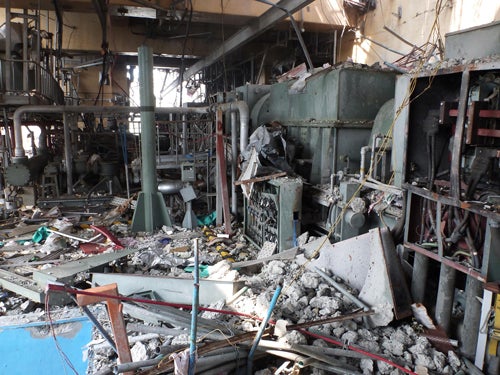
Attempts to decontaminate highly radioactive water at the Fukushima plant are not succeeding on schedule, TEPCO admits, saying that plans to stabilize the plant's runaway reactors by January may need to be revised.
A water treatment facility buried in rubble (left), as pictured outside the Unit 4 reactor building on June 9. Credit: Tokyo Electric Power Company
27 August 2011
Government sources reveal that TEPCO predicted in 2008 that a tsunami could reach a height of more than 15 meters at the Fukushima No. 1 nuclear power plant, contradicting the company’s initial assertions that the size of the March 11 tsunami was "unpredictable."
30 August 2011
The Fukushima prefectural government announces that it will create guidelines to help local residents rid their homes of radioactive contamination. The cleaning guidance will include advice on using high-pressure water cleaners to decontaminate roofs, gutters and walls as well as on removing grass in gardens and replacing decontaminated soil.
20 September 2011
Tens of thousands of people rally in Meiji Park in Tokyo to vent their anger about the Fukushima nuclear crisis and to demand the abolition of atomic power.
Japan pledges to restore reactor units 1 and 3 to stable condition by the end of 2011.
21 September 2011
The Australian reports that towns in the Fukushima area have few places to dispose of the hundreds of thousands of metric tons of contaminated soil created by the nuclear crisis. In Fukushima prefecture it is estimated that 100 million cubic meters of radioactive soil will need to be stored somewhere.
23 September 2011
The Toronto Star reports that the Fukushima prefectural government is trying to capture hundreds of dogs believed to be living in the no-entry zone around the Fukushima power plant. The pets are becoming feral, according to authorities.
14 October 2011
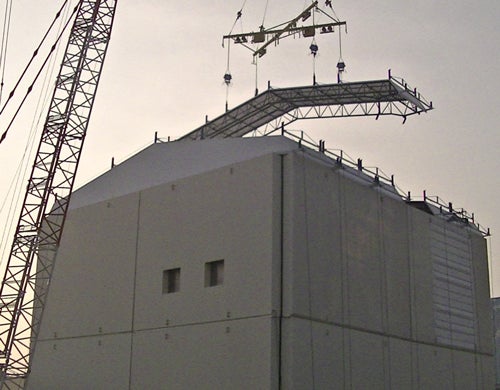 TEPCO finishes installation of a roof to cover the Unit 1 reactor building.
TEPCO finishes installation of a roof to cover the Unit 1 reactor building.
Credit: Tokyo Electric Power Company
19 October 2011
TEPCO announces that the Fukushima plant is emitting 100 million becquerels of radiation per hour, or half of what was emitted a month before and one eight-millionth of the amount released soon after the tsunami hit.
22 October 2011
A survey by the Fukushima Prefecture finds that nearly 70 percent of evacuees have not been able to get jobs since the disaster.
1 November 2011
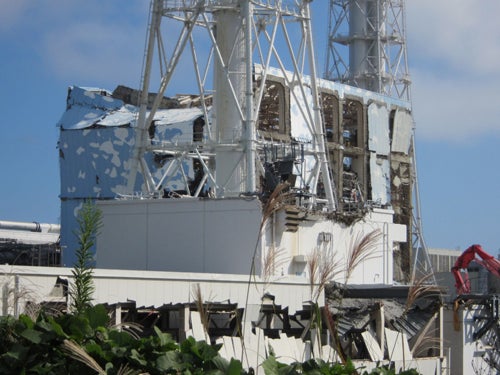
The decommissioning of the four crippled reactors at the Fukushima Daiichi nuclear power plant will likely take more than 30 years to complete, according to a report by Japanese officials.
The reactor building of Unit 3, as pictured on 24 September 2011, remains open to the atmosphere since an explosion on 14 March.
Credit: Tokyo Electric Power Company
In an effort to persuade reporters that radioactive decontamination is really working, a Japanese parliamentary secretary drinks a glass of water from a puddle near the Fukushima power plant.
Japan resumes talks to export its reactor technologies to Vietnam and India.
8 November 2011
A study by Fukushima University finds that more than 25 percent of evacuees do not wish to return home.
17 November 2011
Authorities issue the first ban on rice shipments from the Fukushima Prefecture after samples are found to contain up to 630 becquerels per kilogram, which exceeds the government safety limit by 130 becquerels.
20 November 2011
The Japanese government begins the first decontamination effort within the no-entry zone.
22 November 2011
Ten local elections are finally held, after being postponed due to the March 11 crises. Nuclear power is the main electoral theme.
2 December 2011
The Fukushima prefectural government asks TEPCO to decommission all 10 of its reactors in the prefecture.
7 December 2011
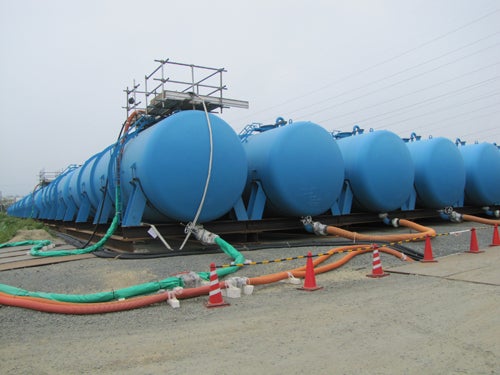
TEPCO says it believes 150 liters of radioactive wastewater leaked into the Pacific Ocean before the company could contain a new leak in the power plant. The water is believed to contain 26 billion becquerels of radioactive material.
A sea of blue tanks store concentrated wastewater. Credit: Tokyo Electric Power Company.
10 December 2011
The Japanese parliament approves agreements with South Korea, Vietnam, Russia and Jordan to go ahead with the sale of nuclear power plants.
16 December 2011
Japanese Prime Minister Yoshihiko Noda announces that all of the reactors at Fukushima Daiichi are in a stable state of cold shutdown. The reactors are being maintained at around 70 degrees C and on-site radiation levels are below one millisievert per year. Experts caution that although the situation has become less dire, a long and dangerous process of cleaning up the radioactive contaminants is ongoing.
29 December 2011
The last remaining evacuation centers in Fukushima Prefecture close. The 448,000 evacuees that had been housed in shelters across three prefectures move to temporary housing units, hotels or apartments.
30 December 2011
According to The Daily Yomiuri, the Fukushima Prefecture's hospital association reports losses of at least $155 million for the first year after the start of the nuclear crisis in March.
1 January 2012
Three months after the government begins allowing citizens to return to the evacuation zone between 20 and 30 kilometers of the power plant, 54 percent of evacuees still have not returned home.
29 January 2012
The Japanese federal government turns down a request to make medical care free for prefectural residents aged 18 and under. "It would be difficult to implement," one official says.
31 January 2012
A disconnected pipe leaks seven metric tons of radioactive water into reactor Unit 4's building. The water reportedly remains inside the power plant and the leak is stopped shortly after its discovery.
2 February 2012
The mayor of the evacuated village of Kawauchi, just over 20 kilometers from the Fukushima plant, announces that local authorities will return in April. He says that schools and clinics will resume services in the village, and he urged residents to return. It is the first time that one of the nine evacuated municipalities has declared it will return.
6 February 2012
Earthworms collected in Kawauchi are found to contain cesium levels as high as 20,000 becquerels per kilogram. Scientists worry that radioactive materials will bio-accumulate up the food chain.
15 February 2012
Tokyo gives $8.5 billion to TEPCO to cover compensation payments. The total amount of financial aid to residents will reach $20 billion.
21 February 2012
A study estimates that 57.8 percent of Fukushima Prefecture residents (excluding nuclear plant workers) were exposed to radiation levels of less than one millisievert during the first four months of the crisis. One millisievert is considered the normal annual limit of radiation exposure. The survey finds that 94.6 percent of residents are considered to have been exposed to less than five millisieverts.
March 2012

One year later the health effects of the radiation released during the Fukushima crisis appear to be minimal; zero deaths occurred as a direct result activities at the nuclear plant.
Of the nine municipalities that were evacuated, the town of Hirono became the first to return and resume operations in March 2012. Areas within 20 kilometers of the plant remain restricted, preventing 78,000 evacuees from returning to their homes.
Only two of Japan's 54 reactors are currently operating; electricity supplies throughout the country are capped as power companies struggle to meet demand.
In prefectures affected by the reactor disaster, 20 percent of businesses still have not resumed operations.
Nuclear safety requirements are becoming more stringent in many countries, including the U.S., as a result of the Fukushima crisis.
Dismantling the Fukushima Daiichi plant and decontaminating the surrounding areas will continue for 30 years.
Credit: Tokyo Electric Power Company